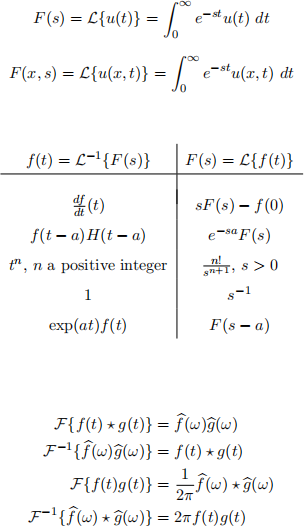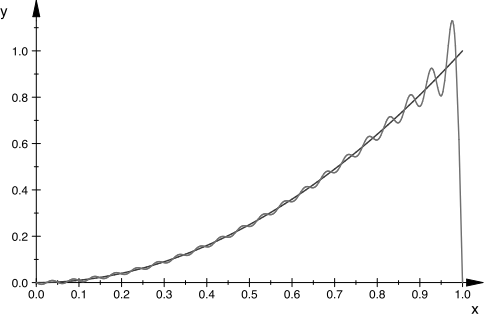MATHS 361 Partial Differential Equations FIRST SEMESTER, 2017
Hello, dear friend, you can consult us at any time if you have any questions, add WeChat: daixieit
MATHS 361
FIRST SEMESTER, 2017
MATHEMATICS
Partial Differential Equations
The formulas below may be used without proving them.

1. (Total marks 12) Suppose f (x) = x2 when x ∈ [0, 1].
(a) Sketch the periodic odd extension of this function on the interval [ -3, 3]. You do NOT need to indicate what happens at any discontinuities. (4 marks)
(b) Sketch the periodic even extension of this function on the interval [ -3, 3]. You do NOT need to indicate what happens at any discontinuities. (4 marks)
(c) The following graph shows f (x) along with a partial sum of the sine series for f (x).

Explain why the partial sum of the sine series has large oscillations around f (x) near the endpoint at x = 1, but not near x = 0. (2 marks)
(d) Would you expect similar large oscillations around f (x) in partial sums of the cosine series of f (x)? If so, where would they occur? Why would you expect, or not expect, to see this behaviour? (2 marks)
2. (Total marks 20) The following equations model heat transfer in a perfectly insulated ring of metal:
ut = uxx - π < x < π, t > 0 (PDE)
u(-π, t) = u(π, t) (boundary condition)
ux(-π, t) = ux(π, t) (boundary condition)
u(x, 0) = f (x) - π < x < π (initial condition)
(a) Ignore the initial condition for now, and suppose that u(x, t) = X(x)T (t). Show that, in that case, X(x) satisfies the following boundary value problem whenever u(x, t) is not identically zero:
X// (x) - βX(x) = 0
X(-π) = X(π)
X/ (-π) = X/ (π)
(6 marks) (b) What is the corresponding differential equation for T (t)? (2 marks)
(c) You may assume (and do not need to show) that a complete linearly independent set of solutions to the boundary value problem for X(x) is given by
{1, cos(nx), sin(nx)}, n = 1, 2, . . . .
(i) Find the values of β that correspond to each function in this set. (4 marks)
(ii) For each element of this set, find the corresponding solution for T (t). (4 marks)
(d) Using your answer to part (c), give the general solution to the PDE with the boundary con- ditions given above. You do not need to give a formula for the coefficients. (4 marks)
3. (Total marks 8) Let the distribution f be defined by
< f, φ >= loo f (t)φ(t) dt
where φ(t) is a test function.
Let H be defined as
H(x) = { 1(0) 0(x) ![]() x(0)
x(0)
Use the definition
< f/ , φ >= - < f, φ/ >
to find the distributional derivative of H(x). (8 marks)
4. (Total marks 16) This question is about finding the solution u(x, t) to the following problem.
ux = 2ut + u, 0 < x < &, t > 0,
u(x, 0) = 6e-3x , 0 < x < & ,
u(x, t) → 0 as x → &
(a) Let F (x, s) be defined as
F (x, s) = /{u(x, t)} = l0 o e-stu(x, t) dt
Use Laplace Transforms to write down a differential equation for F (x, s). (4 marks) (b) Hence find the solution u(x, t) that satisfies the initial and boundary conditions given above. (12 marks)
5. (Total marks 10) The Fourier transform 于(ω) of the function f (t) is defined as
于{ω} = loo f (t)e-iωt dt
Use direct integration to find the Fourier transform of
H(t - 4)e-t/4
(10 marks)
6. (Total marks 18) The convolution w(t) of the functions u(t) and v(t) is defined as
w(t) = loo u(τ )v(t - τ ) dτ
Use the appropriate convolution theorem to find the inverse Fourier transform of
1
(1 + iω)(2 + iω)
Express your answer using the Heaviside function H(t). You may use the result that if a > 0 the
Fourier transform of
f (t) = { 0(e) -at
is
1
a + iω
t > 0
t < 0
(18 marks)
7. (Total marks 16) Consider the boundary value problem
![]()
+ - = sin 2x, u(0) = 0, u(π) = 0
(a) Let G(x, s) be the Green’s function for this problem. Write down
(i) the differential equation satisfied by G(x, s),
(ii) the boundary conditions satisfied by G(x, s), and
(iii) the continuity conditions G(x, s) must satisfy. (4 marks)
(b) Use the differential equation from part (a) to obtain the jump condition that is satisfied by G(x, s). (4 marks)
(c) Find G(x, s) for the above boundary value problem. Do not calculate u(x). (6 marks)
(d) Explain how you would use G(x, s) to find u(x). Do not calculate u(x). (2 marks)
2023-06-12